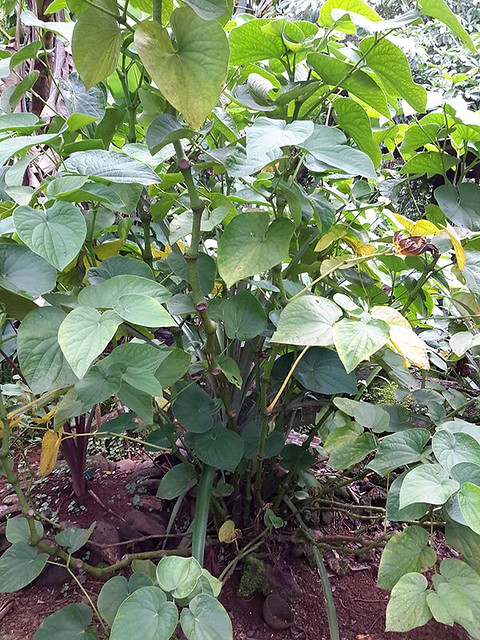Kava: A Popular Plant of the Pacific
Kava (Piper methysticum) is an important ceremonial, traditional, and cash crop grown throughout the Pacific. The evergreen shrub usually grows on hillsides or low-lying mountains, in damp and shady areas. Kava’s rhizomes (underground roots of the plant; Figure 1) are commonly harvested for ancient and modern herbal remedies. When most people refer to kava they are actually referring to either the root or the drink made from squeezing the root (Figure 2). Across the Pacific, kava root is enjoyed both recreationally and ceremonially.
Origin and culture
The origin of the kava plant is unknown. However, many scientific studies suggest that it first originated in Vanuatu – considered by many as the capital of kava. The consumption of kava drinking is known to date back over 3,000 years, primarily for social and ceremonial functions. In Pacific island cultures kava played, and still plays, a significant role in ceremonies such as marriages, funerals, healing ceremonies, naming ceremonies, and initiation events for young boys and girls.
In Pohnpei, Federated States of Micronesia, sakau (kava) drinking is taken very seriously. It is considered to be the only thing that can trump the wrath of a king; if offered sakau, the king or any other person must accept the drink. While Kava drinking originated primarily as a drink reserved for special ceremonial occasions and the elite, today, throughout the Pacific it has become an everyday widely consumed beverage. For example, in Vanuatu, one can visit weekly an array of bars specializing in preparing kava drink.
Kava cultivation and propagation
The kava plant grows in tropical areas where shade and moisture are present. Pohnpei is regarded as the best place to grow kava. All strains of kava are sterile due to the high level of ploidy (sets of complete chromosomes). This means that the kava plant can only reproduce through active culture and propagation, or fragmentation.
Typically, kava is propagated from cuttings taken from stems above the rootstock when the root is harvested. On the surface, older and younger plants are very similar in appearance and size, however, root size can differ significantly. Mature kava plant roots can reach up to two feet in depth. Kava is normally considered mature for harvesting after four years of growing. However, due to recent high demands, farmers have been known to harvest plants as young as eighteen months. However, older plants are preferred to younger plants as they have higher concentrations of kava-lactones, the active medicinal ingredient in kava extracts.
Medical uses and effects
Kava is classified as a depressant drug, meaning it slows down connections between the brain and body by affecting the brain and central nervous system. The kava-lactones in kava are believed to be responsible for such effects. Traditionally, kava has been used by Pacific Islanders as medicine for central and peripheral nervous system ailments. Kava is generally taken by mouth to calm anxiety, stress, restlessness, and to treat sleeping problems. Medically, it has been shown that kava can treat a myriad of symptoms and diseases such as migraines, depression, psychosis, muscle pain and more. Kava is also used in cancer prevention.
Despite its ability to aid in curing diseases and alleviating symptoms, kava is potentially unsafe when taken by mouth and can cause a multitude of side effects (see Table 1). The regular use of kava can lead to severe liver damage. In addition, while under the influence of kava, it can make a person unable to drive or operate machinery safely. For such reasons kava is banned, controlled, or illegal in many European countries. In the US, kava is completely legal, although it causes concern by authorities, such as the FDA and government officials, from time to time. Many countries such as Canada have strict regulations on how kava is sold and imported. These regulations have negatively affected many Pacific Islanders who farm kava as a cash crop for export.
Kava on Guam
Table 1. Short term and long-term effects caused by consumption of Kava root. Taken from Australia’s Alcohol and Drug Foundation (ADF).
| Short Term Effects | Long Term Effects |
|---|---|
| Feeling happy and relaxed | Mood swings |
| Mild sleepiness | Apathy |
| Numb mouth and throat | Dry, scaly skin |
| Reduced or loss of appetite | Getting infections more easily |
| Drowsiness | Shortness of breath |
| Nausea | Chest pains |
| Loss of muscle control | Needing to use more to get the same effect |
| Mild fever | Malnutrition and severe weight loss |
| Pupil dilation and red eyes | Financial, work and social problems |
Although the Mariana Islands contain common vegetation found throughout Oceania, kava is rare on Guam. Culturally, CHamoru people never consumed kava for any known purpose. Kava on Guam is primarily produced and consumed by Micronesians living in Guam. The kava plant is rarely farmed on Guam; typically, it is imported from Fiji in powder form that is mixed with water and then distributed as a beverage. Prices are known to vary from $12 to $18 for 1.5 liters of kava made from kava powder.
In 2011, kava caught the attention of Guam’s courts and the Attorney General’s Office. Authorities raised their concern about the increasing popularity of kava use on Guam. While there are no legal repercussions for consuming kava on Guam, many motorists operate vehicles while under the effects of kava. Although kava intoxication cannot be measured by a breathalyzer, police have been known to arrest motorists who fail field sobriety tests under the influence of kava.
Kava is a common plant found throughout the Pacific and is an important part of Pacific islander culture and medicine. The plant thrives in Pacific tropical mountains where water and shade are a plenty. Kava has helped remedy symptoms and diseases for years and will continue to in the future. While there is still a concern about health, safety and legal regulations throughout the world, kava will always remain as a part of Pacific island culture.
About the author

Christian Potter was a second-generation student in the University of Guam Master of Biology Program. He graduated in 2019. His thesis was “Taxonomic Partitioning of Coral Reefs in Micronesia.” He is also an avid kava drinker.
Editor’s note: This author was a beginning graduate student in 2018 taking a course in scientific writing at the University of Guam. This article was assigned to provide the student with practice in communicating science to non-scientists. The student chose the topic which is related either to their thesis project or work experience. The instructor in the course is Dr. Laurie Raymundo, a UOG Marine Laboratory faculty member.
For further reading
Alcohol and Drug Foundation. “Kava.” Last modified 4 June 20221.
Australian Centre for Agricultural Research. Kava (Piper methysticum) in the South Pacific: Its Importance, Methods of Cultivation, Cultivars, Diseases and Pests. By R.I. Davis and J.F. Brown. Technical Report No 113917. Canberra: ACIAR, 1999.
Kava.com. “Botany of Kava Propagating Kava Plants,” 9 December 2008.
Mingren, Wu. “The Ancient Origins of the Ceremonial Kava Drink of the Pacific.” Ancient Origins: Reconstructing the Story of Humanity’s Past. Last modified 14 July 2014.

